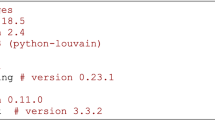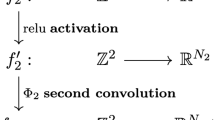Abstract
Optimal mass transportation has been widely applied in various fields, such as data compression, generative adversarial networks, and image processing. In this paper, we adopt the projected gradient method, combined with the homotopy technique, to find a minimal volume-measure-preserving solution for a 3-manifold optimal mass transportation problem. The proposed projected gradient method is shown to be sublinearly convergent at a rate of O(1/k). Several numerical experiments indicate that our algorithms can significantly reduce transportation costs. Some applications of the optimal mass transportation maps—to deformations and canonical normalizations between brains and solid balls—are demonstrated to show the robustness of our proposed algorithms.








Similar content being viewed by others
References
ALICE. http://alice.loria.fr/ (2016)
Bakas, S., Reyes, M., Jakab, A., Bauer, S., Rempfler, M., Crimi, A., Shinohara, R.T., Berger, C., Ha, S.M., Rozycki, M., et al.: Identifying the best machine learning algorithms for brain tumor segmentation, progression assessment, and overall survival prediction in the brats challenge. arXiv:1811.02629 (2018)
Bakas, S., Akbari, H., Sotiras, A., Bilello, M., Rozycki, M., Kirby, J.S., Freymann, J.B., Farahani, K., Davatzikos, C.: Advancing the cancer genome atlas glioma MRI collections with expert segmentation labels and radiomic features. Sci. Data 4, 170117 (2017)
Bonnotte, N.: From Knothe’s rearrangement to Brenier’s optimal transport map. SIAM J. Math. Anal. 45(1), 64–87 (2013). https://doi.org/10.1137/120874850
Brenier, Y.: Polar factorization and monotone rearrangement of vector-valued functions. Commun. Pure Appl. Math. 44(4), 375–417 (1991). https://doi.org/10.1002/cpa.3160440402
Brent, R.P.: Algorithms for Minimization without Derivatives. Prentice-Hall, Englewood Cliffs (1973)
CMG: Combinatorial Multigrid. http://www.cs.cmu.edu/~jkoutis/cmg.html (2021)
David Xianfeng Gu’s Home Page. http://www3.cs.stonybrook.edu/~gu/ (2017)
Digital Shape Workbench-Shape Repository. http://visionair.ge.imati.cnr.it/ontologies/shapes/ (2016)
Engwirda, D., Ivers, D.: Face-centred voronoi refinement for surface mesh generation. Procedia Eng. 82, 8–20 (2014). https://doi.org/10.1016/j.proeng.2014.10.364. 23rd International Meshing Roundtable (IMR23)
Engwirda, D., Ivers, D.: Off-centre steiner points for delaunay-refinement on curved surfaces. Comput.-Aided Des. 72, 157–171 (2016). https://doi.org/10.1016/j.cad.2015.10.007. 23rd International Meshing Roundtable Special Issue: Advances in Mesh Generation
Engwirda, D.: Conforming restricted delaunay mesh generation for piecewise smooth complexes. Procedia Eng. 163, 84–96 (2016). https://doi.org/10.1016/j.proeng.2016.11.024. 25th International Meshing Roundtable
Engwirda, D.: Locally optimal Delaunay-refinement and optimisation-based mesh generation. PhD thesis, University of Sydney http://hdl.handle.net/2123/13148 (2014)
Engwirda, D.: Voronoi-based point-placement for three-dimensional delaunay-refinement. Procedia Eng. 124, 330–342 (2015). https://doi.org/10.1016/j.proeng.2015.10.143. 24th International Meshing Roundtable
Fang, Q., Boas, D.A.: Tetrahedral mesh generation from volumetric binary and grayscale images. In: 2009 IEEE International Symposium on Biomedical Imaging: From Nano to Macro, pp. 1142–1145 (2009). https://doi.org/10.1109/ISBI.2009.5193259
Garg, V., Jaakkola, T.: Solving graph compression via optimal transport. In: Advances in Neural Information Processing Systems 32, pp. 8014–8025. Curran Associates, Inc (2019). http://papers.nips.cc/paper/9014-solving-graph-compression-via-optimal-transport.pdf
Gu, X., Luo, F., Sun, J., Yau, S.T.: Variational principles for Minkowski type problems, discrete optimal transport, and discrete Monge–Ampère equations. Asian J. Math. 20(2), 383–398 (2016). https://doi.org/10.4310/AJM.2016.v20.n2.a7
Haker, S., Zhu, L., Tannenbaum, A., Angenent, S.: Optimal mass transport for registration and warping. Int. J. Comput. Vis. 60(3), 225–240 (2004). https://doi.org/10.1023/B:VISI.0000036836.66311.97
Iso2Mesh. http://iso2mesh.sourceforge.net (2018)
Kantorovich, L.V.: On a problem of Monge. Uspekhi Mat. Nauk 3(2), 225–226 (1948)
Lei, N., Su, K., Cui, L., Yau, S.T., Gu, X.D.: A geometric view of optimal transportation and generative model. Comput. Aided Geom. Des. 68, 1–21 (2019). https://doi.org/10.1016/j.cagd.2018.10.005
Menze, B.H., Jakab, A., Bauer, S., Kalpathy-Cramer, J., Farahani, K., Kirby, J., Burren, Y., Porz, N., Slotboom, J., Wiest, R., Lanczi, L., Gerstner, E., Weber, M., Arbel, T., Avants, B.B., Ayache, N., Buendia, P., Collins, D.L., Cordier, N., Corso, J.J., Criminisi, A., Das, T., Delingette, H., Ç. Demiralp, Durst, C.R., Dojat, M., Doyle, S., Festa, J., Forbes, F., Geremia, E., Glocker, B., Golland, P., Guo, X., Hamamci, A., Iftekharuddin, K.M., Jena, R., John, N.M., Konukoglu, E., Lashkari, D., Mariz, J.A., Meier, R., Pereira, S., Precup, D., Price, S.J., Raviv, T.R., Reza, S.M.S., Ryan, M., Sarikaya, D., Schwartz, L., Shin, H., Shotton, J., Silva, C.A., Sousa, N., Subbanna, N.K., Szekely, G., Taylor, T.J., Thomas, O.M., Tustison, N.J., Unal, G., Vasseur, F., Wintermark, M., Ye, D.H., Zhao, L., Zhao, B., Zikic, D., Prastawa, M., Reyes, M., Van Leemput, K.: The multimodal brain tumor image segmentation benchmark (brats). IEEE Trans. Med. Imag. 34(10), 1993–2024 (2015). https://doi.org/10.1109/TMI.2014.2377694
Parikh, N., Boyd, S.: Proximal algorithms. Found. Trends Optim. 1(3), 123–231 (2013)
Pinkall, U., Polthier, K.: Computing discrete minimal surfaces and their conjugates. Exp. Math. 2, 15–36 (1993)
Rachev, S.T., Rüschendorf, L.: Mass Transportation Problems, vol. 1–2. Springer, Berlin (1998)
Sorkine, O., Alexa, M.: As-rigid-as-possible surface modeling. In: Proceedings of EUROGRAPHICS/ACM SIGGRAPH Symposium on Geometry Processing, pp. 109–116 (2007)
Su, Z., Wang, Y., Shi, R., Zeng, W., Sun, J., Luo, F., Gu, X.: Optimal mass transport for shape matching and comparison. IEEE Trans. Pattern Anal. Mach. Intell. 37(11), 2246–2259 (2015). https://doi.org/10.1109/TPAMI.2015.2408346
Su, K., Chen, W., Lei, N., Zhang, J., Qian, K., Gu, X.: Volume preserving mesh parameterization based on optimal mass transportation. Comput. Aided Des. 82, 42–56 (2017). https://doi.org/10.1016/j.cad.2016.05.020
The Stanford 3D Scanning Repository. http://graphics.stanford.edu/data/3Dscanrep/ (2016)
Tran, A.P., Fang, Q.: Generating high quality tetrahedral meshes of the human head and applications in fnirs. In: Biophotonics Congress: Biomedical Optics Congress 2018 (Microscopy/Translational/Brain/OTS), pp. JTu3A.52. Optical Society of America (2018). https://doi.org/10.1364/TRANSLATIONAL.2018.JTu3A.52
TurboSquid. http://www.turbosquid.com/ (2016)
Villani, C.: The Wasserstein Distances, pp. 93–111. Springer, Berlin, HeidelbergBerlin, Heidelberg (2009)
Yueh, M.H., Lin, W.W., Wu, C.T., Yau, S.T.: An efficient energy minimization for conformal parameterizations. J. Sci. Comput. 73(1), 203–227 (2017). https://doi.org/10.1007/s10915-017-0414-y
Yueh, M.H., Li, T., Lin, W.W., Yau, S.T.: A novel algorithm for volume-preserving parameterizations of 3-manifolds. SIAM J. Imag. Sci. 12(2), 1071–1098 (2019). https://doi.org/10.1137/18M1201184
Yueh, M.H., Lin, W.W., Wu, C.T., Yau, S.T.: A novel stretch energy minimization algorithm for equiareal parameterizations. J. Sci. Comput. 78(3), 1353–1386 (2019). https://doi.org/10.1007/s10915-018-0822-7
Author information
Authors and Affiliations
Corresponding author
Additional information
Publisher's Note
Springer Nature remains neutral with regard to jurisdictional claims in published maps and institutional affiliations.
The work by M.-H. Yueh, T.-M. Huang and W.-W. Lin was partially supported by Ministry of Science and Technology Grants 109-2115-M-003-010-MY2, 108-2115-M-003-012-MY2 and 106-2628-M-009-004, respectively. The work by T. Li was partially supported by National Natural Science Foundation of China (NSFC) Grant 11971105. The work by the authors was partially supported by the National Center for Theoretical Sciences (NCTS), the Nanjing Center for Applied Mathematics (NCAM), and the Shing-Tung Yau Center and the Big Data Computing Center of Southeast University.
Appendices
Area-Weighted Stretching Energy Minimization [35]
Let \({\mathcal {M}}\) be a simply connected tetrahedral mesh and \(\rho \) be a density function on \({\mathcal {M}}\). Let \(g:\partial {\mathcal {M}}\rightarrow {\mathbb {S}}^2\) be a piecewise affine map induced by \({\mathbf {g}}=[({\mathbf {g}}^1)^\top , ({\mathbf {g}}^2)^\top , ({\mathbf {g}}^3)^\top ]^\top \). We define the area-weighted stretching energy functional by
where \(L_{\mathbb {A}}(g)\) is the area-weighted Laplacian matrix with
in which \(\sigma _{g}(\alpha ) = \frac{\rho (\alpha ) |\alpha |}{|g(\alpha )|}\) is the stretching factor of g on the triangular face \(\alpha =[v_i,v_j,v_k]\) or \([v_j,v_i,v_\ell ]\), and \(\theta _{i,j}(g)\) and \(\theta _{j,i}(g)\) are two angles opposite to the edge \(g([v_i,v_j])\). We summarize area-weighted stretching energy minimization (ASEM) for the computation of spherical area-measure-preserving parameterizations below.

Proof of Lemmas
1.1 Proof of Lemma 1
(i) Let \({\mathbf {g}}_{\tau } = {\mathbf {g}}^{(k)} + \tau ({\mathbf {g}}^* - {\mathbf {g}}^{(k)})\) be the line segment between \({\mathbf {g}}^{(k)}\) and \({\mathbf {g}}^*\) for \(\tau \in [0,1]\). Then, we have
From property (26) and (24)–(25) with \({\mathbf {h}}={\mathbf {g}}^*\) or \({\mathbf {g}}^{(k)}\), we have
\(\square \)
1.2 Proof of Lemma 2
For convenience, we now delete the superscript "k" and denote
and
(i) From (39)–(41), it follows that
This implies that
From the Cauchy–Schwarz theorem and Lemma 1 (i), we have
(ii) Similar to the proof of (i), by setting \({\mathbf {g}}^* = {\mathbf {g}}\), we obtain
\(\square \)
Rights and permissions
About this article
Cite this article
Yueh, MH., Huang, TM., Li, T. et al. Projected Gradient Method Combined with Homotopy Techniques for Volume-Measure-Preserving Optimal Mass Transportation Problems. J Sci Comput 88, 64 (2021). https://doi.org/10.1007/s10915-021-01583-z
Received:
Revised:
Accepted:
Published:
DOI: https://doi.org/10.1007/s10915-021-01583-z




